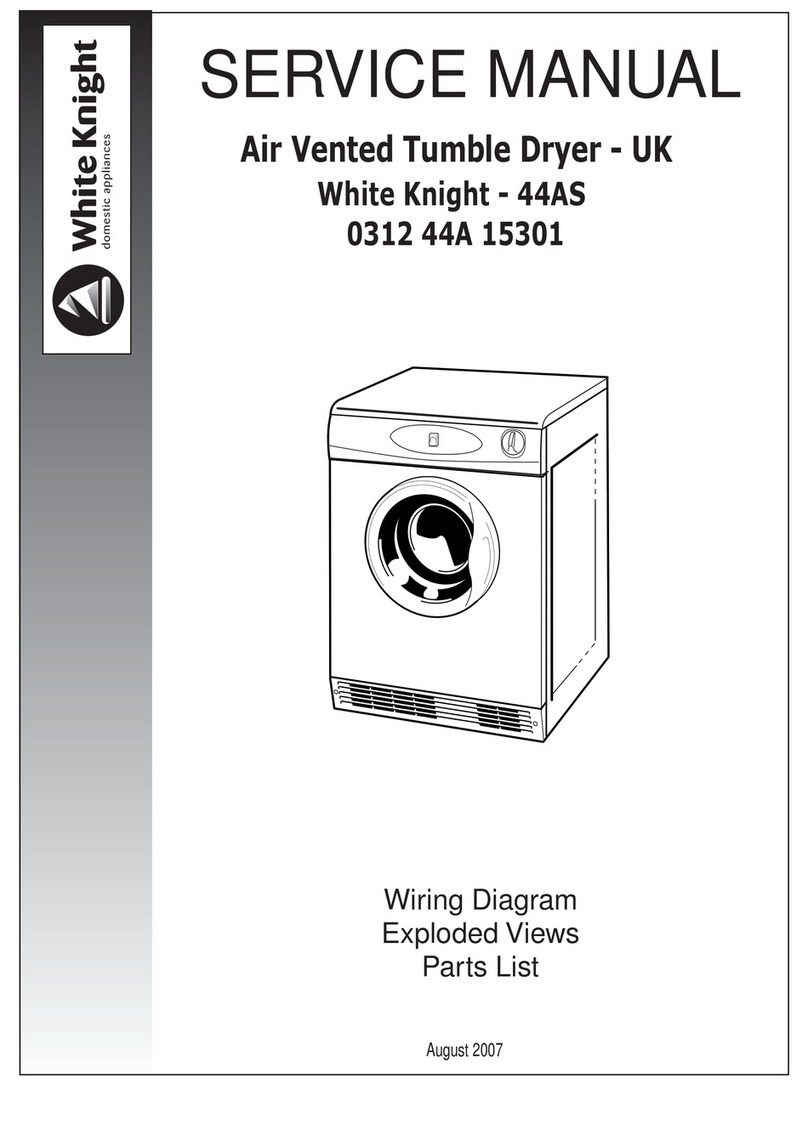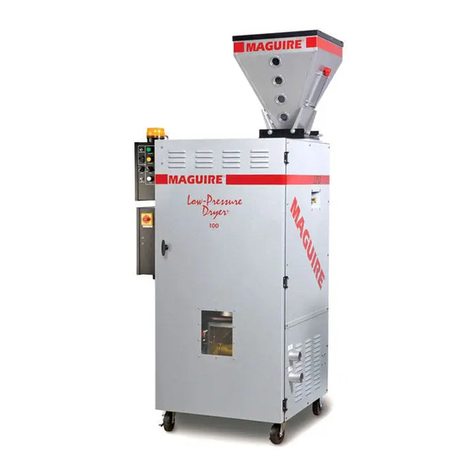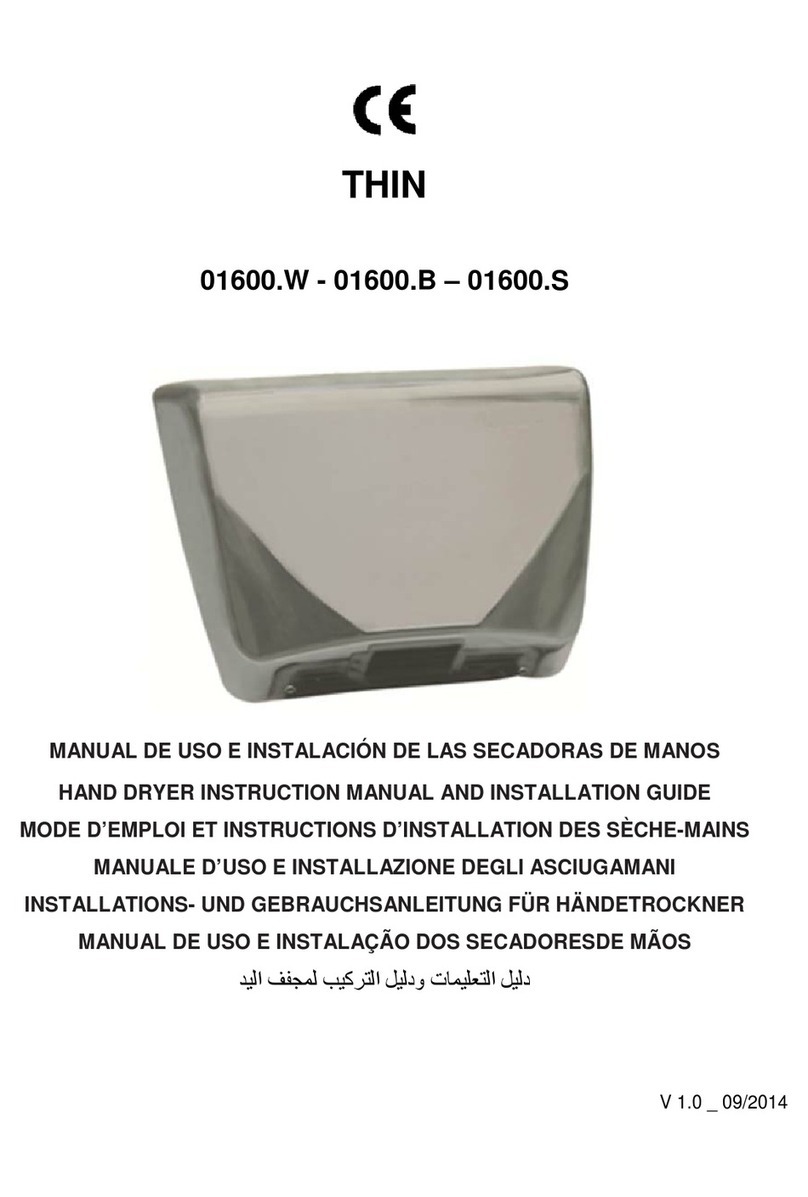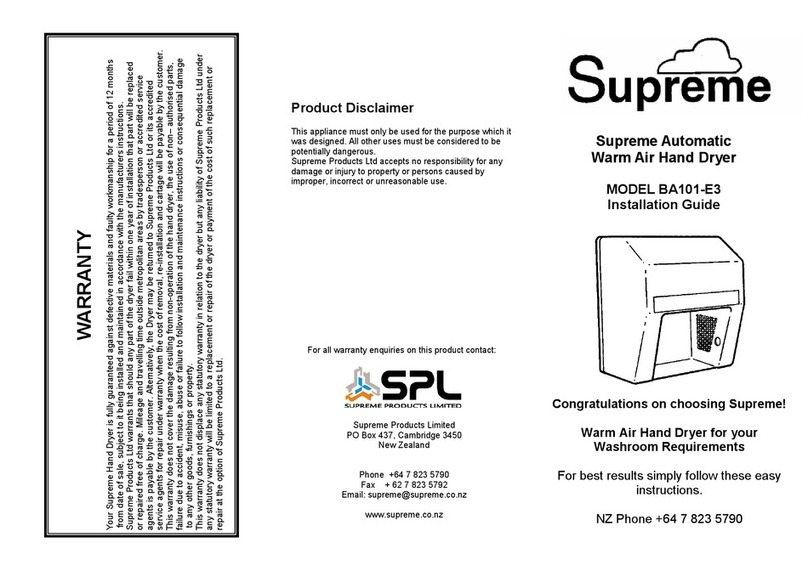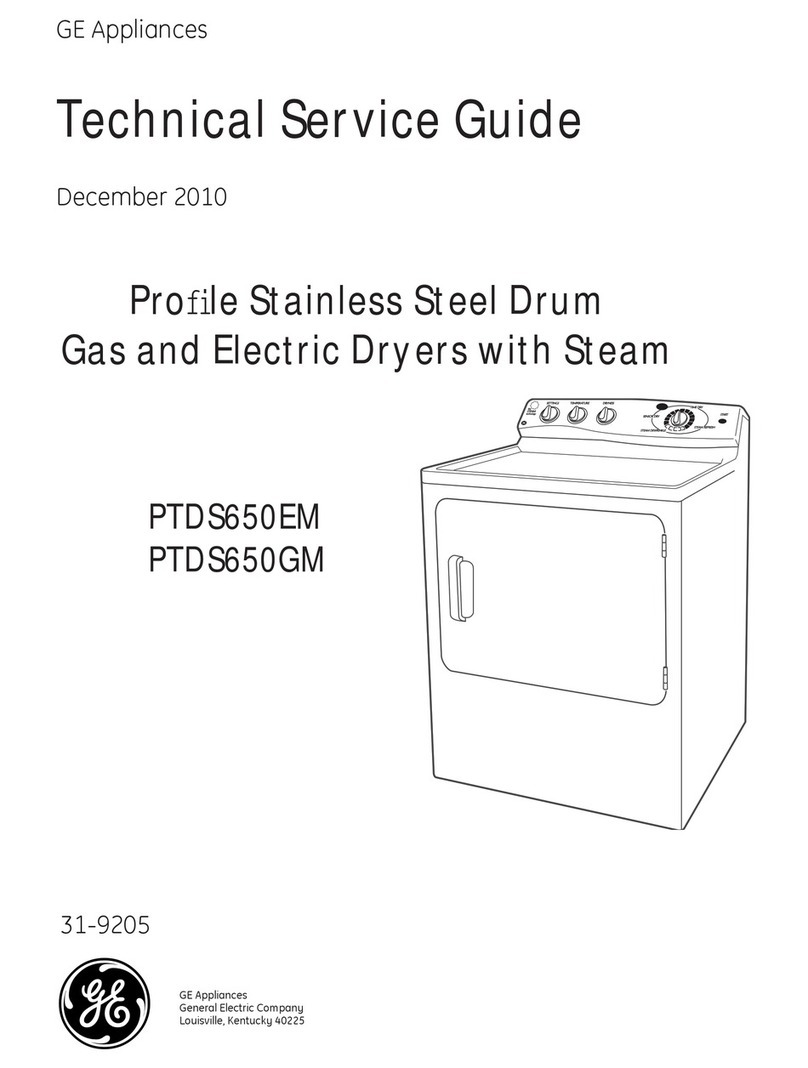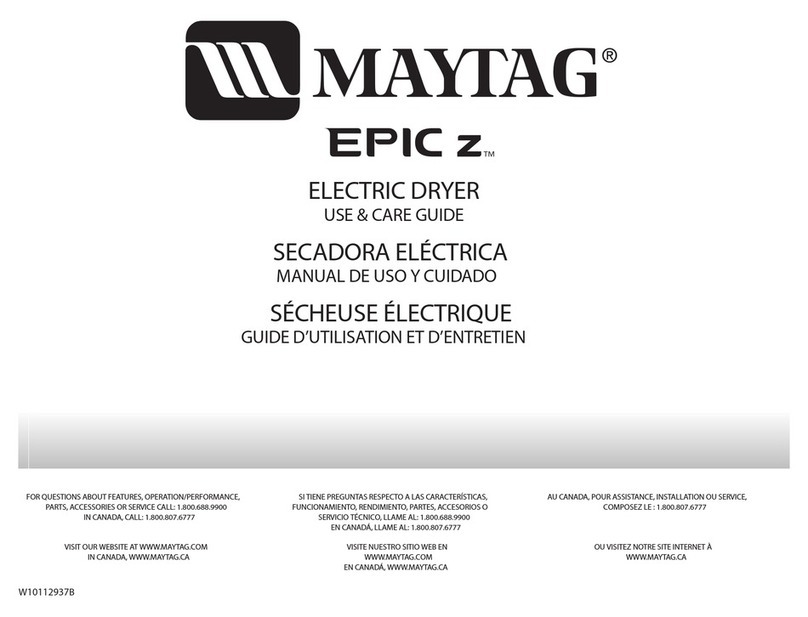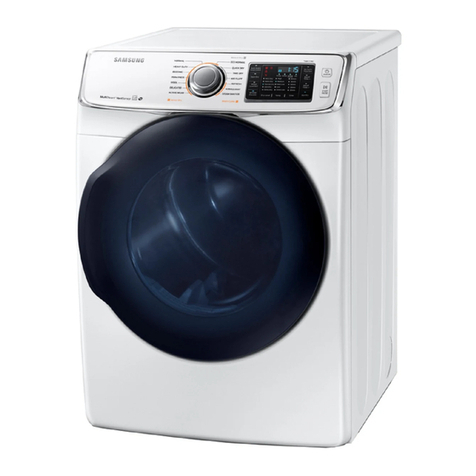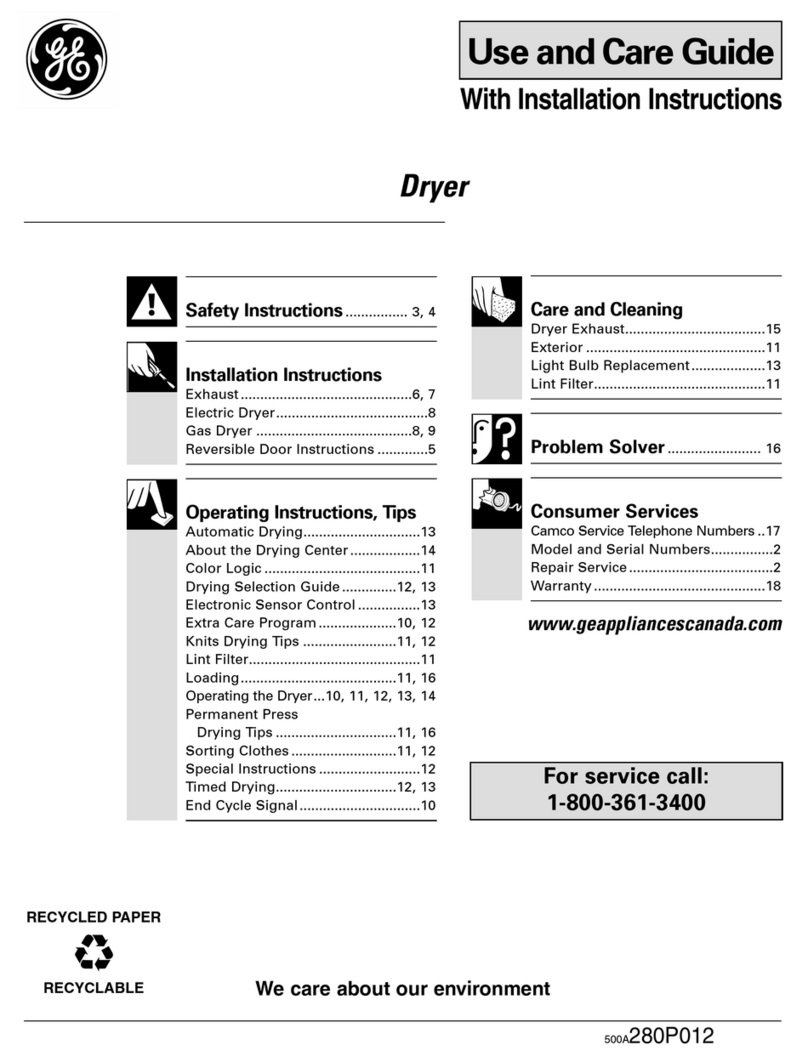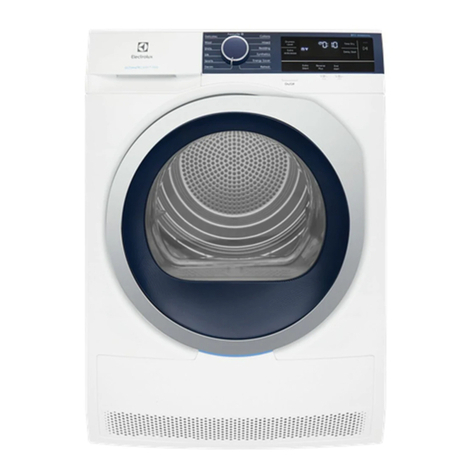SelectLine 600103364 User manual

600103364
EN USER MANUAL FR MANUEL D’UTILISATION
Air vented tumble dryer (p. 2) Sèche-linge à évacuation d’ain (p. 12)
ES MANUAL DE UTILIZACIÓN PT MANUAL DE UTILIZAÇÃO
Secadora con ventilación (p. 22) Máquina de secar roupa com ventila-
ção a ar (p. 32)
PL INSTRUKCJA OBSŁUGI HU HASZNÁLATI ÚTMUTATÓ
Suszarka bebnowa wentylacyjna
(s. 43)
Légkivezetéses szárítógép (54 o.)
RO MANUAL DE UTILIZARE RU РУКОВОДСТВО ПОЛЬЗОВАТЕЛЯ
Uscator de rufe cu aerisire (uscător
rufe) (p. 64)
Сушильная машина с вентиляцией
(c. 75)
UA ІНСТРУКЦІЯ З ЕКСПЛУАТАЦІЇ
Сушильна машина з вентиляцією
(c. 86)

2
EN
1
2
3
4
5
6
7
8
9
10
11
12
7 KG
13 14 15 16
An i C ase
Mix
Cotton
7 KG
An i Crea
Synthetic
1H

EN
3
1/ SAFETY INFORMATION
Before using this vented tumble dryer, please read the following instructions carefully and
keep these instructions for future reference.
1. This appliance can be used by children aged from 8 years and above and persons with
reduced physical, sensory or mental capabilities or lack of experience and knowledge
if they have been given supervision or instruction concerning use of the appliance
in a safe way and understand the hazards involved. Children shall not play with the
appliance. Cleaning and user maintenance shall not be made by children without
supervision.
2. Children of less than 3 years should be kept away unless continuously supervised.
3. The appliance is not intended for use by persons (including children) with reduced
physical, sensory or mental capabilities, or lack of experience and knowledge, unless
they have been given supervision or instruction concerning use of the appliance by a
person responsible for their safety.
4. Children should be supervised to ensure that they do not play with the appliance.
5. If the supply cord is damaged, it must be replaced by the manufacturer, its service
agent or similarly qualied persons in order to avoid a hazard.
6. The maximum mass of dry textile material in kilograms to be used in the appliance is
7.0 kg.
7. The tumble dryer is NOT to be used if industrial chemicals have been used for cleaning.
8. The lint trap has to be cleaned frequently.
9. The lint must not to be allowed to accumulate around the tumble dryer.
10. Adequate ventilation has to be provided to avoid the back ow of gases into the room
from appliances burning other fuels, including open res.
11. Do not dry unwashed items in the tumble dryer.
12. Items that have been soiled with substances such as cooking oil, acetone, alcohol,
petrol, kerosene, spot removers, turpentine, waxes, and wax removers should be
washed in hot water with an extra amount of detergent before being dried in the
tumble dryer.
13. Items such as foam rubber (latex foam), shower caps, waterproof textiles, rubber
backed articles, and clothes or pillows tted with foam rubber pads should not be
dried in the tumble dryer.
14. Fabric softeners, or similar products, should be used as specied by the fabric softener
instructions.
15. Remove all objects from pockets such as lighters and matches.
16. WARNING: Never stop a tumble dryer before the end of the drying cycle unless all
items are quickly removed and spread out so that the heat is dissipated.
17. WARNING: The appliance must not be supplied through an external switching device,
such as a timer, or connected to a circuit that is regularly switched on and o by a
utility.
18. The ventilation openings in the base must not be obstructed by a carpet.
TABLE OF CONTENTS:
1/ SAFETY INFORMATION ____________________________________________________________________________ P.3
2/ TECHNICAL DATA _________________________________________________________________________________ P.5
3/ DESCRIPTION ____________________________________________________________________________________ P.6
4/ INSTALLATION ___________________________________________________________________________________ P.6
5/ USE ____________________________________________________________________________________________ P.7
6/ MAINTENANCE AND CLEANING_____________________________________________________________________ P.9
7/ TROUBLESHOOTING ______________________________________________________________________________ P.10
8/ WARRANTY AND LIMITATIONS OF LIABILITY__________________________________________________________ P.10

EN
4
19. The exhaust air must not be discharged into a ue which is used for exhausting fumes
from appliances burning gas or other fuels.
20. The appliance must not be installed behind a lockable door, a sliding door, or a door
with a hinge on the opposite side to that of the tumble dryer, in such a way that a full
opening of the tumble dryer door is restricted.
21. The tumble dryer can NOT be placed on top of a washing machine.
22. Oil-aected items can ignite spontaneously, especially when exposed to heat sources
such as in a tumble dryer. The items become warm, causing an oxidation reaction in
the oil. Oxidation creates heat. If the heat cannot escape, the items can become hot
enough to catch re. Piling, stacking, or storing oil-aected items can prevent heat
from escaping and so create a re hazard.
23. The appliance should not be overturned during normal use or maintenance.
24. Do not plug or unplug the product from the electrical outlet with wet hands.
25. Do not operate the appliance with a damaged cord or plug, or after the appliance
malfunctions or is dropped or damaged in any manner. Prior to operation, check the
device for physical damage.
26. The appliance is to be connected to a socket-outlet having earthing contact.
27. Install the tumble dryer into an easily accessible socket outlet located near the
appliance.
28. Install or store where it will not be exposed to temperatures below freezing or exposed
towater or weather,whichcouldcausepermanentdamageandinvalidatethewarranty.
29. Keep the area around the exhaust opening and adjacent surrounding areas free from
the accumulation of lint, dust, and dirt. An obstructed port might reduce the airow.
30. Thoroughly spin the laundry in the washing machine. The high spin speed can reduce
the drying time and save energy.
31. Make sure combustible sprays will not be close to the dryer when it is working, and
once the gas leaks, do not touch the plug, or start/pause it.
32. Do not wash or dry articles that have been cleaned in, washed in, soaked in, or spotted
with combustible or explosive substances (such as wax, oil, paint, gasoline, degreasers,
dry-cleaning solvents, kerosene, etc.).
33. Never attempt to operate this appliance if it is damaged, malfunctioning, partially
disassembled or has missing or broken parts, including a damaged cord or plug.
34. Do not allow children on or in the appliance. Close supervision of children is necessary
when the appliance is used near children.
35. Do not use the appliance when your hands are wet.
36. Do not store plastic, paper, or clothing that may burn or melt on top of the dryer during
operation.
37. The exhaust air must not be discharged into a ue which is used for exhausting fumes
from appliances burning gas or other fuels.
38. Do not dry articles containing rubber, plastic, or similar materials such as padded bras,
tennis shoes, galoshes, bath mats, rugs, bibs, baby pants, raincoats, plastic bags, or
pillows that may melt or burn. Some rubber materials, when heated, can under certain
circumstances produce re by spontaneous combustion.
39. Thedoorshallbeopenedonlyaftertheprogrammeofthedryingmachineiscompleted.
Do not open the door before the programme is nished to avoid the human skin from
being scalded by hot steam or an overheated drying machine.
40. Remove all packaging materials before using the appliance. Keep the packaging
materials away from children they pose a risk of swallowing and suocation.
41. The tumble dryer is not intended for outdoor use.
42. Before connecting the tumble dryer, ensure that the connection data on the data
plate (fuse rating, voltage, and frequency) match the mains electricity supply. If in any
doubt, consult a qualied electrician.
43. Do not connect the tumble dryer to the mains electricity supply by an extension
lead. Extension leads are a re hazard and do not guarantee the required safety of the
appliance.

EN
5
44. This marking indicates that this product should not be disposed with other
householdwastesthroughouttheEU.Topreventpossibleharmtotheenvironment
or human health from uncontrolled waste disposal, recycle it responsibly to
promote the sustainable reuse of material resources.To return your used device, please
use the return and collection systems or contact the retailer where the product was
purchased. They can take this product for environmental safe recycling.
POWER SUPPLY AND GROUNDING
1. The tumble dryer employs alternating current with the rated voltage and frequency.
2. When the voltage uctuates between 6% of the rated voltage, the tumble dryer can
work normally.
3. A special power socket with a capacity of 10 A for the tumble dryer
had better be set beside the dryer for convenience and safety. The
method of connection of the socket is as the picture on the right.
4. For your safety, please make improvements as soon as possible
according to the rules and suggestions mentioned above.
5. The appliance corresponds to protection class I and may only be connected to a plug
with a protective conductor that has been installed properly. When connecting the
appliance to the mains, make sure that the mains voltage is correct. You can nd more
information about this on the rating plate.
6. The electrical safety of this tumble dryer can only be guaranteed when correctly
earthed. It is essential that this standard safety requirement is met. If in any doubt,
please have the household wiring system tested by a qualied electrician.
7. The manufacturer cannot be held liable for the consequences of an inadequate
earthing system (e.g. electric shock).
8. WARNING: The socket and the grounding wire must be installed by an electrician to
prevent incorrect installation or use of the socket and to guarantee the safe use of
electricity. No connection between the grounding wire and the neutral wire, otherwise
the cabinet will be charged, which is likely to cause the danger of electric shock.
2/ TECHNICAL DATA
Model 600103364 Anti-Crease Yes
Rated voltage 220-240 V~ Child lock (Combined) Yes
Rated frequency 50 Hz Diameter of inner tub (mm) 566 mm
Rated input power 2000 W Door diameter (mm) 310 mm
Rated capacity* 7.0kg (weight of dry laundry) Door outer frame diameter (outer) 415 mm
Drum capacity 97.5 L Net dimensions (W x D x H) 595 × 555× 840 mm
Drum type Zinc Gross dimensions (W x D x H) 665 × 565 × 890 mm
Door type Full door Maximum net weight in kg 31.5 kg
Gross weight in kg 34kg
Display colour Red
Automatic stop Yes
Machine colour White
Digital countdown No
Motor Universal
Temperature setting No
Motor type
Classic
Delay No
* The rated capacity is the maximum capacity. Make sure that the dry clothes which are loaded to the appliance do not exceed
the rated capacity at any time.
Grounding

EN
6
PRODUCT FICHE
Model 600103364
Rated capacity 7.0 kg
Dryer type Air-Vented
Energy eciency class C
Weighted annual energy consumption (AEc) 519.1 kWh/year
Automatic or non-automatic Automatic
EU Eco-label N/A
Energy consumption of the standard cotton programme
Weighted energy consumption of the standard cotton programme at full and partial load 3.22kWh
Energy consumption of the standard cotton programme at full load 4.49kWh
Energy consumption of the standard cotton programme at partial load 2.27kWh
Power consumption of the o-mode (Po) 0.46 W
Power consumption of the left-on mode (Pl) 0.49 W
Duration of the left-on mode 10 min
Programme time of the ’Standard Cotton programme’
Weighted programme time of the standard cotton programme at full and partial load 104min
Programme time of the standard cotton programme at full load 142min
Programme time of the standard cotton programme at partial load 75min
Sound power level for the standard cotton programme at full load 69dB
Remarks:
Energy consumption per year, based on 160 drying cycles of the standard cotton programme at full and partial load, and the
consumption of the low-power modes. Actual energy consumption per cycle will depend on how the appliance is used.
The programme Cotton Standard used at full and partial load is the standard drying programme to which the information
in the label and the che relates. This programme is suitable for drying normal wet cotton laundry and it is the most ecient
programme in terms of energy consumption for cotton.
3/ DESCRIPTION
1. Top board
2. Control panel
3. Door
4. Lint lter
5. Front panel
6. Side panel
7. Drum
8. Door lock
9. Power plug
10. Exhaust duct
11. Four height adjustable screw feet
12. Anti-Crease
13. Start/Pause
14. Dryness level
(Extra/Standard/Less)
15. Programme
(Mix/Cotton/Synthetic/1H)
16. On/O
4/ INSTALLATION
SELECTION OF INSTALLATION POSITION
Notice when installing:
• Do not install the tumble dryer in the open air or in a place where it can be damaged easily
by rain.
• Do not place the back of the dryer near a curtain or anything that may be moved by the wind.
• Do not place the tumble dryer near gas or ammable materials.
The dryer should be placed in a well-ventilated area with at least a 10 cm distance from the wall
to allow adequate air circulation. There should not be any obstacles within 1.5 meters in front of
the tumble dryer to assure adequate ventilation.
WARNING: Do not block the gap between the bottom of the tumble dryer and the oor with
plinth facings, deep pile carpet, etc. This would hinder a sucient ow of air to the dryer.
LEVELLING THE TUMBLE DRYER
The appliance must be perfectly level to ensure safe and proper operation. Once in its permanent
operating position, check that the tumble dryer is completely level using a spirit level. If it is not,
adjust the feet with a proper tool.
Note: If the tumble dryer is not placed horizontally (tilt angle more than 2°), it may not work
properly.
>10cm

EN
7
EXHAUST DUCT INSTALLATION
• Connect one end of the ex tube to the back vent, then x it rmly until it’s tight.
• The other end of the ex tube will be extended to the outdoor. For the proper assembly please
refer to the below pictures.
5/ USE
BEFORE EACH DRYING
1. Thoroughly spin the laundry in the washing machine before drying. The high spin speed can shorten the drying time and
reduce energy consumption.
2. To obtain a uniform drying result, sort the laundry by fabric type and drying programme.
3. Before drying, close zips, hooks, eyelets, button-ups, tie fabric belts, sew in or remove under-wiring from bras, etc.
4. Do not over-dry your clothes, as over dry clothes can crease easily.
5. Do not dry articles containing rubber or similar elastic materials.
6. Do not open the door until the dryer programme has nished.
7. Do not open the door before the end of the programme to avoid scalding human skin with hot steam or an overheated
dryer.
8. Clean the lint lter each time you use the appliance to avoid extending drying time and energy consumption.
9. Do not dry clothes after the dry cleaning process.
Reference weight of dry clothes (each)
Sweater
(about 800g)
Jacket
(about 800g
cotton)
Jeans
(about 800g)
Bath towel
(about 900g
cotton)
Single bed-sheet
(about 600g
cotton)
Work clothes
(about 1120g)
Sleepwear
(about 200g)
Long sleeve shirt
(about 300g
cotton)
T-shirt
(about 180g
cotton)
Underwear
(about 70g cotton)
Socks
(about 50g
mixed-weave)
Note:
• Do not overload the dryer.
• Not suitable for dripping wet textiles. The tumble dryer may be damaged or even cause a re.
• Not suitable for silk or wool fabrics.
Only dry laundry that is suitable for tumble drying. Check the labels for washing:
Suitable for tumble drying
Normal drying process: Tumble drying in the tumbler is possible under normal load and temperature 80°.
Mild drying process: Caution is appropriate when tumble drying. Select mild process with reduced thermal action.
Do not tumble dry: Articles unsuitable for drying in the tumbler.

EN
8
QUICK START
Note: Prior to use, ensure the tumble dryer is installed properly.
1. Before drying
123
Plug in to the mains electricity supply. Load the laundry into the drum. Close the door.
2. Drying
Turn on. Select a function of default. Start.
3. After drying
Note: After nished drying, the buzzer will beep.
1
2
3
Take the laundry out from the
tumble dryer. Clean the lint lter. Disconnect the tumble dryer
from the mains electricity
supply.
CONTROL PANEL
7 KG
Anti Crease
Mix
Cotton
7 KG
Anti Creas
Synthetic
1H
1. Switch the tumble dryer on by pressing the On/O button in.
2. Select the programme by pressing the programme button ( Mix/ Cotton/ Synthetic/ 1H) repeatedly until the
indicator for the desired programme lights up.
3. Press the drying level button ( Extra/ Standard/ Less) repeatedly until the indicator for the desired drying level
lights up.
4. Press the Anti-Crease button to activate the Anti-Crease function. The indicator will light up.
5. Press the Start/Pause button to start.
6. To activate the child lock function, press the programme button and the drying level button simultaneously for
3seconds. The indicator will light up.
7. A buzzer sounds to let you know the programme has nished. Press the On/O button to turn o the tumble dryer.
Disconnect the tumble dryer from the mains electricity supply.
8. Clean the lint lter, cabinet and drum. For more information regarding cleaning, refer to <MAINTENANCE AND CLEANING>
section.
Notes:
• The symbol indicates the standard programme, which is the most suitable to dry normal cotton load at rated capacity.
• The Cotton + Standard programme is suitable to dry normal wet cotton laundry and it is the most ecient programme in
terms of energy consumption for drying wet cotton laundry.

EN
9
DRYING PROGRAMMES TABLE
Programme Maximum load Application/Properties
Cotton
Extra 7.0 kg For the complete drying of single or multi-layer cotton laundry for direct
storage.
Standard 7.0kg
Less 7.0 kg For single-layer cotton laundry that is to remain damp for ironing.
Mix Extra 3.5 kg For thick or multi-layer mixed fabrics to be dried completely.
Standard 3.5 kg For mixed fabrics from cotton and synthetics.
Synthetics
Extra 3.5 kg For thick or multi-layer synthetic fabrics to be dried completely.
Standard 3.5 kg To dry thin synthetic textiles, which are not ironed, such as easy care
shirts, baby cloths or socks.
1H 1.0 kg To dry individual items.
Note: Select the suitable programme and drying level according to the type and capacity of the fabric.
1. During the last 3 minutes of the drying cycle, there is no heating to cool down the load. (Exception: The cool down time is
10 minutes for the 1H programme.)
2. If the Anti-Crease option is selected, the entire anti-crease cycle will take 2 hours. Without the Anti-Crease option, the cycle
will end after 30 minutes.
3. The room temperature and humidity will inuence the drying time.
4. Check the clothes care label and select the appropriate programme accordingly.
5. Recommendation: For a load of less than 0.5 kg, select the 1H programme and the Extra drying level for drying.
CONSUMPTION DATA
Programme Capacity Spin speed/Residual humidity Drying time Energy consumption
Cotton standard 7.0 kg 1000 rpm/60% 142 min 4.49 kWh
Cotton standard 3.5 kg 1000 rpm/60% 75 min 2.27 kWh
Synthetic standard 3.5 kg 800 rpm/40% 47 min 1.45 kWh
Note:
• Thick or multi-layered fabrics, e.g. jackets, etc., are not easy to dry. You had better choose the Cotton Extra programme.
• As uneven material, thick and multi-layered clothes are not easy to dry, it is better to choose the appropriate time drying
programme to completely dry them if some parts of the clothes are still damp after the programme nishes.
• All data are measured in accordance with EN 61121. The actual consumption may dier from the values given in the table,
depending on the amount of the laundry, type of fabric, residual moisture, and any additional functions selected.
6/ MAINTENANCE AND CLEANING
SAFETY RESET
1. This tumble dryer has a safety cut-out switch which is activated by temperature.
2. If the tumble dryer does not heat up, reset it. Press the “safety reset” button and wait a minimum of 10 minutes before
restarting the appliance.
Note: The safety reset button is on the backboard of the tumble dryer.
3. The most common reason for the tumble dryer to overheat is a blocked lter.
4. Clean the lint lter after each cycle to prevent overheating of the tumble dryer.
The cut-out switch may operate for the following reasons:
• The lint lter is blocked.
• Exhaust outlets are blocked at the back of the dryer.
• Poor ventilation in the room. Open the windows or the door.
• Lightweight garment e.g. handkerchief, sucked over the lter.
SAFETY RESET BUTTON
Use your nger or a pencil to press the button until you feel its click.
Note: The safety reset button is on the backboard of the tumble dryer.
LINT FILTER CLEANING
The lint which is created by the drying process is collected in the lint lter in the door.Clean the lint lter
after each drying cycle. Remove the lint lter by pulling it straight up.
1. Cleaning whilst dry
Use a cloth or your ngers to remove the lint from the surface of the lter. Remove any lint from the hollow
part of the door opening. Also, clean the seal with a damp cloth. Once clean, push the lint lter back into the
door holder until it clicks into place. Ensure it is facing the correct way.
2. Cleaning with water
If there is still a great deal of compacted lint on the lter after cleaning it as described above, rinse the lter
under hot, running water. Dry the lint lter carefully and thoroughly before installing it.
Safety reset button

EN
10
CABINET AND DRUM CLEANING
WARNING! Disconnect the tumble dryer from the mains electricity supply.
• Clean the housing, control panel, and door seal with a slightly damp cloth and a mild detergent
or soapy water. After cleaning, dry all parts with a soft cloth.
• The drum and other stainless steel parts can be cleaned with a suitable stainless steel cleaner
following the manufacturer’s instructions.
• Do not use solvents, abrasive cleaners, glass cleaners, or all-purpose cleaners. These could
damage plastic surfaces and other parts.
• The tumble dryer must never be hosed down.
7/ TROUBLESHOOTING
With the help of the following notes minor faults in the performance of the appliance, some of which may result from incorrect
operation, can be put right without contacting the Service Centre.
Repair work to electrical appliances should only be carried out by a suitably qualied person in strict accordance with current
local and national safety regulations. Repairs and other work by unqualied persons could be dangerous. The manufacturer
cannot be held liable for unauthorized work.
Problem Possible cause Remedy
The tumble dryer does not
start.
The power is cut o. Wait for the power to be restored.
The power plug is not fully inserted. Check the power socket and make sure the plug is rmly
inserted.
The tumble dryer is overloaded. Clothes must be spun and the load to be dried must not
exceed the rated capacity (7 kg weight of dry laundry).
The temperature fuse has blown. Restore temperature fuse.
A hot or burning smell is
coming from the appliance.
The lint lter is clogged. Clean the lint lter after each cycle.
The inlet or exhaust duct is clogged. Clean the exhaust duct.
The clothes are too dry.
The tumble dryer is overloaded. Do not exceed rated capacity (7 kg weight of dry laundry).
Clothes are not removed in time
after completion. Remove clothes immediately after the end of the
programme.
Clothes are not sorted properly.
Observe the care label on clothes.
The selected temperature is too
high.
Clothes shrink Laundry is over-dried.
Observe the care label on clothes.
If clothes are sensitive to shrinkage, check the clothes
after they are dry. Take out the clothes when damp.
Then hang the clothes until they are completely dry.
Pilling in clothes Laundry is sensitive to rubbing. Use fabric softener to lubricate the bres, sprinkle
laundry starch on the cus and neckline while ironing the
garments. Turn the laundry inside out to avoid pilling.
• Heavy, wet clothes rotating and hitting the walls of the tumble dryer will make noise when the appliance is running.
• During the drying cycle, the tumble dryer creates an airow that makes a noise when it is hitting the drum.
OTHER FAILURE
Display Possible cause Remedy
LEDs“Less”and “Standard”ashing. Damaged temperature sensor or PCB failure. If there is a problem, contact your
local service centre.
Extra LED ashing. Temperature sensor is short-circuited or PCB error.
8/ WARRANTY AND LIMITATIONS OF LIABILITY
This product is guaranteed for a period of 24 months (dened by local law) from the date of purchase against any failure
resulting from manufacturing or material defects.
This warranty does not cover damage caused by improper installation, improper use, or normal wear and tear of the product.
More specically, the warranty does not cover:
-Damage or problems caused by improper use, accident, alteration or electrical connection of improper intensity or voltage.
-Modied products, those whose warranty seal or serial number have been damaged, altered, removed or oxidized.
-Replaceable batteries and accessories are guaranteed for a period of 6 months.
-Failure of the battery due to overcharging or failure to observe the safety instructions explained in the instruction manual.
-Cosmetic damage, including scratches, dents, or any other element.
-Damage caused by any intervention carried out by an unauthorised person.
-Defects caused by normal wear and tear or due to normal ageing of the product.
-Software updates due to a change in network settings.
-Product failures due to the use of third party software to modify, change or adapt the existing software.
-Product failures caused by use without accessories approved by the manufacturer.
-Oxidised products.
Under no circumstances can the manufacturer be responsible for the loss of data stored on the disk. Similarly, the manufacturer
is not required to verify that the SIM/SD cards are removed from the returned products.
Repaired or replaced products may include new and/or reconditioned components and equipment.

EN
11
Terms and conditions of implementation:
To obtain a warranty service, you are requested to return your product to the customer service desk of your retail outlet with
your proof of purchase (receipt, invoice, …), the product and its supplied accessories, with its original packaging.
It is important to have the date of purchase, the model and the serial or IMEI number on hand as information (this information
usually appears on the product, the packaging or your proof of purchase).
Failing this, you must return the product with the accessories necessary for its proper operation (power supply, adaptor, etc.).
In the event that your claim is covered by the warranty, the after-sales service may, within the limits of local law, either:
-Repair or replace defective parts.
-Exchange the returned product with a product that has at least the same functionality and that is equivalent in terms of
performance.
-Refund the product at the purchase price of the product mentioned on the proof of purchase.
If one of these 3 solutions is used, this does not give rise to the extension or renewal of the warranty period.

12
1
2
3
4
5
6
7
8
9
10
11
12
7 KG
13 14 15 16
A t fr ssage
Mixte
Coton
7 KG
Anti Cre se
Synthétique
1H
FR

FR
13
1/ CONSIGNES DE SÉCURITÉ
Avant d'utiliser ce sèche-linge à évacuation, veuillez lire attentivement les instructions
suivantes et les conserver pour référence ultérieure.
1. Cet appareil peut être utilisé par des enfants âgés de 8ans et plus ainsi que par des
personnes dont les capacités physiques, sensorielles et mentales sont réduites, ou des
personnes dénuées d’expérience ou de connaissance, si ceux-ci ont bénéficié d’une
surveillance ou d’instructions préalables concernant l’utilisation de l’appareil en toute
sécurité et comprennent les dangers encourus. Les enfants ne doivent pas prendre cet
accessoire pour un jouet. Le nettoyage et l’entretien usuel par l’utilisateur ne doivent
pas être effectués par des enfants sans surveillance.
2. Les enfants de moins de 3ans doivent être tenus à l’écart, à moins qu’ils ne soient sous
une surveillance continue.
3. Cet appareil n’est pas prévu pour être utilisé par des personnes (y compris les
enfants) dont les capacités physiques, sensorielles ou mentales sont réduites, ou des
personnes dénuées d’expérience ou de connaissance, sauf si elles ont pu bénéficier,
par l’intermédiaire d’une personne responsable de leur sécurité, d’une surveillance ou
d’instructions préalables concernant l’utilisation de l’appareil.
4. Les enfants doivent être surveillés afin qu’ils ne puissent pas jouer avec cet appareil.
5. Si le cordon est endommagé, il doit être remplacé par le fabricant, son agent d’entretien
ou une personne qualifiée pour éviter tout danger.
6. Le poids maximum de matière textile sèche en kilogrammes à utiliser dans l'appareil
est de 7,0 kg.
7. Le sèche-linge NE doit PAS être utilisé si des produits chimiques industriels ont été
utilisés pour le nettoyage.
8. Le filtre à peluche doit être nettoyé fréquemment.
9. Les peluches ne doivent pas s'accumuler autour du sèche-linge.
10. Une ventilation adéquate doit être fournie pour éviter un retour des gaz dans la pièce à
partir d’appareils fonctionnant avec d’autres combustibles, y compris des flammes nues.
11. Ne faites pas sécher du linge qui n’a pas été lavé dans le sèche-linge.
12. Les vêtements qui ont été souillés avec des substances telles que l'huile de cuisson,
l'acétone, l'alcool, l'essence, le kérosène, les détachants, la térébenthine, les cires et les
décapantspourciredoiventêtre lavés àl'eauchaudeavecunequantitésupplémentaire
de détergent avant d'être séchés dans le sèche-linge.
13. Les articles tels que mousse de caoutchouc (mousse de latex), bonnets de douche,
textiles imperméables, articles recouverts de caoutchouc et vêtements ou oreillers munis
de tampons en mousse de caoutchouc ne doivent pas être séchés dans le sèche-linge.
14. Les adoucissants ou les produits similaires doivent être utilisés conformément à leurs
instructions.
15. Videz les poches de tous les objets, tels que briquets et allumettes.
16. MISE EN GARDE : N’arrêtez pas un sèche-linge avant la fin du cycle de séchage, à
moins que le linge ne soit retiré et étalé rapidement afin de dissiper la chaleur.
SOMMAIRE:
1/ CONSIGNES DE SÉCURITÉ __________________________________________________________________________ P.13
2/ CARACTÉRISTIQUES TECHNIQUES___________________________________________________________________ P.16
3/ DESCRIPTION ____________________________________________________________________________________ P.17
4/ INSTALLATION ___________________________________________________________________________________ P.17
5/ UTILISATION _____________________________________________________________________________________ P.17
6/ ENTRETIEN ET NETTOYAGE_________________________________________________________________________ P.20
7/ DÉPANNAGE _____________________________________________________________________________________ P.20
8/ GARANTIE ET LIMITES DE RESPONSABILITÉ __________________________________________________________ P.21

14
17. MISEENGARDE:Ne pasalimenterl'appareilpar undispositifde commutationexterne,
tel qu'une minuterie, ou un branchement à un circuit qui est régulièrement allumé et
éteint par un service public.
18. Les ouvertures de ventilation de la base ne doivent pas être obstruées par un tapis.
19. L'air évacué ne doit pas être rejeté dans un conduit de fumée utilisé pour l'évacuation
des fumées d'appareils brûlant du gaz ou d'autres combustibles.
20. L’appareilnedoitpasêtreinstalléderrièreuneporteverrouillable,une porte coulissante
ou une porte pourvue de charnières du côté opposé au sèche-linge, de sorte à ne pas
réussir à ouvrir entièrement la porte du sèche-linge.
21. Le sèche-linge ne doit PAS être placé au-dessus d'une machine à laver.
22. Les vêtements souillés d'huile peuvent s'enammer spontanément, surtout lorsqu'ils
sont exposés à des sources de chaleur comme dans un sèche-linge. Les vêtements
deviennent chauds, provoquant une réaction d'oxydation dans l'huile. L'oxydation
crée de la chaleur. Si la chaleur ne peut pas s'échapper, les vêtements peuvent devenir
assez chauds pour prendre feu. Empiler ou entreposer des vêtements touchés par
l'huile peut empêcher la chaleur de s'échapper et créer ainsi un risque d'incendie.
23. L'appareil ne doit pas être renversé lors d'une utilisation ou d'un entretien normal.
24. Ne pas brancher ou débrancher le produit de la prise électriques avec les mains humides.
25. Ne faites pas fonctionner l’appareil avec une che secteur ou un câble d’alimentation
endommagé, après un dysfonctionnement ou si l’appareil tombe ou est endommagé
de quelque façon que ce soit. Avant tout fonctionnement, vériez si l’appareil ne
présente pas des dégâts physiques.
26. L'appareil doit être connecté à une prise de courant avec un contact de mise à la terre.
27. Installez le sèche-linge dans une prise de courant facilement accessible située à
proximité de l'appareil.
28. Installez ou stockez dans un endroit où il ne sera pas exposé à des températures
inférieures au point de congélation, à l'eau ou aux intempéries, ce qui pourrait causer
des dommages permanents et annuler la garantie.
29. Evitez l'accumulation de peluches, de poussière et de saleté dans la zone autour de
l'ouverture d'échappement et des zones environnantes adjacentes. Un orice obstrué
peut réduire le ux d'air.
30. Essorez soigneusement le linge dans la machine à laver. La vitesse d'essorage élevée
peut réduire le temps de séchage et économiser de l'énergie.
31. Vériez que les aérosols combustibles ne se trouvent pas à proximité du sèche-linge
lorsqu'il fonctionne, et si le gaz fuit, ne pas toucher la prise, ne pas la démarrer / ne pas
la mettre en pause.
32. Ne pas laver, ni sécher des vêtements qui ont été nettoyés, lavés, trempés ou tachés
par des substances combustibles ou explosives (la cire, l'huile, la peinture, l'essence,
dégraissants, solvants de nettoyage à sec, kérosène, etc.).
33. Ne jamais faire fonctionner cet appareil s'il est endommagé, défectueux, partiellement
démonté ou s'il a des pièces manquantes ou cassées, y compris un cordon ou une
prise endommagés.
34. Ne pas laisser les enfants sur ou dans l'appareil. Une surveillance étroite des enfants
est nécessaire lorsque l'appareil est utilisé à proximité.
35. Ne pas utiliser l'appareil avec les mains mouillées.
36. Ne pas ranger de plastique, de papier ou de vêtements susceptibles de brûler ou de
fondre sur le dessus du sèche-linge pendant son fonctionnement.
37. L'air évacué ne doit pas être rejeté dans un conduit de fumée utilisé pour l'évacuation
des fumées d'appareils brûlant du gaz ou d'autres combustibles.
38. Ne pas sécher de vêtements contenant du caoutchouc, du plastique ou des matériaux
similaires tels que des soutiens-gorge rembourrés, des chaussures de tennis, des tapis
de bain, des couvertures, des bavoirs, des pantalons de bébé, des imperméables, des
sacs en plastique ou des oreillers qui peuvent fondre ou brûler. Certaines matières en
caoutchouc, lorsqu'elles chauent, peuvent dans certaines circonstances produire un
incendie par combustion spontanée.
FR

FR
15
39. La porte ne doit être ouverte qu'une fois le programme terminé. N'ouvrez pas la porte
avant la n du programme pour éviter toute brûlure par de la vapeur chaude ou un
sèche-linge surchaué.
40. Enleveztouslesmatériauxd’emballageavantd’utiliserl’appareil.Éloignezlesmatériaux
d’emballage des enfants pour éviter tout risque d’ingestion et d’étouement.
41. Le sèche-linge n'est pas destiné à une utilisation extérieure.
42. Avant de brancher le sèche-linge, assurez-vous que les données de connexion sur
la plaque signalétique (calibre du fusible, tension et fréquence) correspondent à
l'alimentation secteur. En cas de doute, consultez un électricien qualié.
43. Ne raccordez pas le sèche-linge au réseau électrique avec une rallonge. Les rallonges
constituent un risque d'incendie et ne garantissent pas la sécurité requise de l'appareil.
44. Ce symbole indique que cet accessoire ne doit pas être jeté avec les autres ordures
ménagères au sein de l’UE. Par mesure de prévention pour l’environnement et
pour la santé humaine, veuillez le recycler de façon responsable, conformément
au principe de réutilisation des ressources matérielles. Pour renvoyer votre ancien
accessoire, veuillez utiliser les systèmes de renvoi et de collecte ou contacter le
revendeur auprès duquel vous avez acheté l’accessoire. Ils pourront procéder au
recyclage de cet accessoire en toute sécurité.
ALIMENTATION ET MISE À LA TERRE
1. Le sèche-linge utilise un courant alternatif avec la tension et la fréquence nominales.
2. Lorsque la tension uctue entre 6 % de la tension nominale, le sèche-linge peut
fonctionner normalement.
3. Une prise de courant spéciale d'une capacité de 10 A pour le sèche-linge
doit être placée à côté du sèche-linge pour plus de commodité et de
sécurité. La méthode de branchement de la prise est indiquée sur
l'image de droite.
4. Pour votre sécurité, merci d'apporter des améliorations dès que possible selon les
règles et suggestions mentionnées ci-dessus.
5. L'appareil correspond à la classe de protection I et ne peut être raccordé qu'à une che
équipée d'un conducteur de protection correctement installé. Lors du raccordement
del'appareil au secteur, assurez-vous quelatension secteurest correcte.Vous trouverez
plus d'informations sur la plaque signalétique.
6. La sécurité électrique de ce sèche-linge ne peut être garantie que s'il est correctement
mis à la terre. Il est essentiel que cette exigence de sécurité standard soit remplie. En
cas de doute, veuillez faire tester le système de câblage domestique par un électricien
qualié.
7. Le fabricant ne peut être tenu responsable des conséquences d'une mise à la terre
inadéquate (ex. choc électrique).
8. MISE EN GARDE: La prise et le l de mise à la terre doivent être installés par un
électricien pour éviter toute installation ou utilisation incorrecte de la prise et pour
garantir une utilisation sûre de l'électricité. Aucune connexion entre le l de mise à la
terre et le l neutre, sinon l'armoire sera chargée, ce qui est susceptible de provoquer
un risque de choc électrique.
Mise à
la terre

16
2/ CARACTÉRISTIQUES TECHNIQUES
Modèle 600103364 Antifroissage Oui
Tension nominale 220-240 V~ Verrouillage enfant (Combiné) Oui
Fréquence nominale 50 Hz Diamètre de la cuve intérieure (mm) 566 mm
Puissance d'entrée nominale 2 000 W Diamètre de la porte (mm) 310 mm
Capacité nominale* 7,0 kg (poids du linge sec) Diamètre du cadre extérieur de la
porte (extérieur) 415 mm
Capacité du tambour 97.5 L Dimensions nettes (L x P x H) 595 × 555× 840 mm
Type de tambour Zinc Dimensions brutes (L x P x H) 665 × 565 × 890 mm
Type de porte Porte pleine Poids net maximum en kg 31.5 kg
Poids brut en kg 34kg
Couleur d'achage Rouge
Arrêt automatique Oui
Couleur de la machine Blanc
Décompte numérique Non
Moteur Universel
Réglage de la température Non
Type de moteur Classique
Délai Non
* La capacité nominale est la capacité maximale. Assurez-vous que les vêtements secs qui sont chargés dans l'appareil ne
dépassent pas la capacité nominale.
FICHE PRODUIT
Modèle 600103364
Capacité nominale 7,0 kg
Type de séchage A ventilation
Classe d'ecacité énergétique C
Consommation d'énergie annuelle pondérée (AEc) 519,1 kWh/an
Automatique ou non-automatique Automatique
Label écologique de l'UE N/A
Consommation d'énergie du programme coton standard
Consommation d'énergie pondérée du programme coton standard à pleine charge et à
charge partielle 3,22kWh
Consommation d'énergie du programme coton standard à pleine charge 4,49kWh
Consommation d'énergie du programme coton standard à charge partielle 2,27kWh
Consommation d'énergie du mode arrêt (Po) 0.46 W
Consommation d'énergie du mode en marche (Pl) 0,49 W
Durée du mode en marche 10 min
Durée du programme « Programme coton standard »
Durée du programme pondéré du programme coton standard à pleine charge et à charge partielle 104min
Durée du programme coton standard à pleine charge 142min
Durée du programme coton standard à charge partielle 75min
Niveau de puissance sonore pour le programme coton standard à pleine charge 69dB
Remarques :
Consommation d'énergie par an, basée sur 160 cycles de séchage du programme coton standard à pleine charge et à charge
partielle, et la consommation des modes basse consommation. La consommation d'énergie réelle par cycle dépendra de la
façon dont l'appareil est utilisé.
Le programme Coton Standard utilisé à pleine et demi-charge est le programme de séchage standard auquel se rapportent
les informations de l'étiquette et de la che. Ce programme convient au séchage du linge en coton normalement humide et il
est plus ecace en termes de consommation d'énergie pour le coton.
FR

FR
17
3/ DESCRIPTION
1. Plateau supérieur
2. Panneau de contrôle
3. Porte
4. Filtre à peluche
5. Panneau frontal
6. Panneau latéral
7. Tambour
8. Verrou de porte
9. Prise électrique
10. Conduit d'évacuation
11. Quatre pieds à vis réglables en
hauteur
12. Antifroissage
13. Démarrage/Pause
14. Niveau de séchage
(Extra/Standard/Moins)
15. Programme
(Mixte/Coton/Synthétique/1H)
16. Marche/Arrêt
4/ INSTALLATION
CHOIX DE LA POSITION D'INSTALLATION
Remarque lors de l'installation :
•N'installezpaslesèche-lingeà l'air libre ou dans un endroitoùilpeutêtrefacilement endommagé
par la pluie.
•Ne placez pas l'arrière du sèche-linge près d'un rideau ou de tout objet susceptible d'être
déplacé par le vent.
• Ne placez pas le sèche-linge à proximité de gaz ou de matériaux inammables.
Le sèche-linge doit être placé dans une zone bien ventilée à une distance d'au moins 10 cm
du mur pour permettre une circulation d'air adéquate. Ne placez aucun obstacle à moins de
1,5 mètre devant le sèche-linge pour assurer une ventilation adéquate.
MISE EN GARDE : Ne bloquez pas l'espace entre le bas du sèche-linge et le sol avec des plinthes,
de la moquette épaisse, etc. Cela empêcherait un ux d'air susant vers le sèche-linge.
MISE À NIVEAU DU SÉCHE-LINGE
L'appareil doit être parfaitement à niveau pour assurer un fonctionnement sécurisé et correct.
Une fois dans sa position permanente de fonctionnement, vériez que le sèche-linge est bien
stable à l'aide d'un niveau à bulle. Si ce n'est pas le cas, ajustez les pieds avec un outil approprié.
Remarque : Si le sèche-linge n'est pas placé à l'horizontale (angle d'inclinaison supérieur à 2°),
il risque de ne pas fonctionner correctement.
INSTALLATION DU CONDUIT D'ÉVACUATION
•Connectez une extrémité du tube exible à l'évent arrière, puis xez-le fermement jusqu'à ce
qu'il soit serré.
•L'autre extrémité du tube exible sera prolongée vers l'extérieur. Pour un montage correct,
veuillez vous référer aux images ci-dessous.
5/ UTILISATION
AVANT CHAQUE SÉCHAGE
1. Essorez soigneusement le linge dans la machine à laver avant le séchage. La vitesse d'essorage élevée peut réduire le temps
de séchage et économiser de l'énergie.
2. Pour obtenir un résultat de séchage uniforme, triez le linge par type de tissu et programme de séchage.
3. Avant le séchage, fermez les fermetures éclair, les crochets, les œillets, les boutonnières, nouez les ceintures en tissu, cousez
ou retirez les armatures des soutiens-gorge, etc.
4. Ne séchez pas trop vos vêtements, s'ils sont trop secs, ils peuvent se froisser facilement.
5. Ne séchez pas d'articles contenant du caoutchouc ou des matériaux élastiques similaires.
6. N'ouvrez pas la porte avant la n du programme de séchage.
7. N'ouvrez pas la porte avant la n du programme pour éviter de vous brûler avec la vapeur chaude ou un sèche-linge
surchaué.
8. Nettoyez le ltre à peluches chaque fois que vous utilisez l'appareil pour éviter d'augmenter le temps de séchage et la
consommation d'énergie.
9. Ne séchez pas les vêtements après le processus de nettoyage à sec.
>10cm

18
Poids de référence des vêtements secs (l'unité)
Pull-over
(environ 800g)
Veste
(environ
800g coton)
Jeans
(environ 800g)
Serviette de bain
(environ
900g coton)
Drap 1 place
(environ
600g coton)
Vêtements de
travail
(environ 1120g)
Vêtements de nuit
(environ 200g)
Chemise à manche
longue
(environ
300g coton)
T-shirt
(environ
180g coton)
Sous-vêtements
(environ 70g coton)
Chaussettes
(environ 50g de
tissage mixte)
Remarque :
• Ne surchargez pas le sèche-linge.
• Ne convient pas aux textiles mouillés qui gouttent. Le sèche-linge peut être endommagé ou même provoquer un incendie.
• Ne convient pas aux tissus en soie ou en laine.
Ne séchez que du linge adapté au sèche-linge. Vériez les étiquettes pour le lavage :
Convient au sèche-linge
Processus de séchage normal : Le séchage en tambour est possible avec une charge normale et une température
de 80°.
Processus de séchage doux : La prudence est de mise lors du séchage en machine. Sélectionner un processus doux
avec une action thermique réduite.
Ne pas sécher en machine : Vêtements impropres au séchage en sèche-linge.
DÉMARRAGE RAPIDE
Remarque : Avant utilisation, assurez-vous que le sèche-linge est correctement installé.
1. Avant le séchage
123
Branchez-le sur le secteur électrique. Chargez le linge dans le tambour. Fermez la porte.
2. Séchage
Mise en marche. Sélectionnez une fonction
par défaut. Démarrez.
3. Après le séchage
Remarque : Une fois le séchage terminé, le minuteur émettra un bip.
FR

FR
19
123
Sortez le linge du sèche-linge. Nettoyez le ltre à peluche. Débranchez le sèche-linge du
secteur électrique.
PANNEAU DE CONTRÔLE
7 KG
Antifro ssage
Mixte
Coton
7 KG
Anti Crease
Synthétique
1H
1. Allumez le sèche-linge en appuyant sur le bouton Marche/Arrêt.
2. Sélectionnez le programme en appuyant sur le bouton programme ( Mixte/ Coton/ Synthétique/ 1H) plusieurs
fois jusqu'à ce que le voyant du programme souhaité s'allume.
3. Appuyez sur le bouton de niveau de séchage ( Extra/ Standard/ Moins) plusieurs fois jusqu'à ce que le voyant du
niveau de séchage souhaité s'allume.
4. Appuyez sur le bouton Antifroissage pour activer cette fonction. Le voyant s'allume.
5. Appuyez sur le bouton Démarrage/Pause pour démarrer.
6. Pour activer la fonction verrouillage enfant, appuyez sur le bouton programme et le bouton niveau de séchage
simultanément pendant 3 secondes. Le voyant s'allume.
7. Un signal sonore retentit pour vous informer que le programme est terminé. Appuyez sur le bouton Marche/Arrêt pour
éteindre le sèche-linge. Débranchez le sèche-linge du secteur électrique.
8. Nettoyez le ltre à peluche, le boîtier et le tambour. Pour plus d'informations sur le nettoyage, reportez-vous à la section
<ENTRETIEN ET NETTOYAGE>.
Remarques :
• Le symbole indique le programme standard, qui est le plus approprié pour sécher une charge de coton normale à la
capacité nominale.
•Le programme Coton + Standard convient au séchage du linge en coton humide normal et est le programme le plus ecace
en termes de consommation d'énergie pour le séchage du linge en coton humide.
TABLEAU DES PROGRAMMES DE SÉCHAGE
Programme Charge maximale Application/Propriétés
Coton
Extra 7,0 kg Pour le séchage complet du linge en coton simple ou multicouche pour un
stockage direct.
Standard 7,0 kg
Moins 7,0 kg Pour le linge en coton à une épaisseur qui doit rester humide pour le repassage.
Mixte Extra 3,5 kg Pour les tissus mixtes épais ou multicouches à sécher complètement.
Standard 3,5 kg Pour les tissus mixtes en coton et synthétique.
Synthétique
Extra 3,5 kg Pour tissus synthétiques épais ou multicouches à sécher complètement.
Standard 3,5 kg Pour sécher des textiles synthétiques ns, qui ne sont pas repassés, tels que
des chemises d'entretien facile, des linges pour bébé ou des chaussettes.
1H 1,0 kg Pour sécher des articles individuels.
Remarque: Sélectionnez le programme adapté et le niveau de séchage selon le type et la capacité.
1. Pendant les 3 dernières minutes du cycle de séchage, il n'y a pas de chauage pour refroidir la charge. (Exception: La durée
de refroidissement est de 10 minutes pour le programme 1H.)
2. Si l'option Anti-froissage est sélectionnée, le cycle anti-froissage complet prendra 2 heures. Sans l'option Anti-froissage, le
cycle se terminera après 30 minutes.
3. La température ambiante et l'humidité inuenceront le temps de séchage.
4. Vériez l'étiquette d'entretien des vêtements et sélectionnez le programme approprié.
5. Recommandation : Pour une charge inférieure à 0,5 kg, sélectionnez le programme 1H et le niveau de séchage Extra pour
le séchage.
DONNÉES DE CONSOMMATION
Programme Capacité Vitesse d'essorage/
Humidité résiduelle Temps de
séchage Consommation
électrique
Coton standard 7,0 kg 1000 tm/60% 142 min 4,49 kWh
Coton standard 3,5 kg 1000 tm/60% 75 min 2,27 kWh
Synthétique standard 3,5 kg 800 tm/40% 47 min 1,45 kWh

20
Remarque :
•Tissus épais ou multicouches, par ex. les vestes, etc. ne sont pas faciles à sécher. Vous devriez opter pour le programme
Coton Extra.
•Les matériaux irréguliers, les vêtements épais et multicouches n'étant pas faciles à sécher, il est préférable de choisir le
programme de séchage approprié pour les sécher complètement si certaines parties des vêtements sont encore humides
après la n du programme.
•Toutes les données sont mesurées conformément à la norme EN 61121. La consommation réelle peut être diérente
des valeurs indiquées dans le tableau, en fonction de la quantité de linge, du type de tissu, de l'humidité résiduelle et des
fonctions supplémentaires sélectionnées.
6/ ENTRETIEN ET NETTOYAGE
RÉINITIALISATION DE LA SÉCURITÉ
1. Ce sèche-linge est équipé d'un interrupteur de sécurité qui est activé par la température.
2. Si le sèche-linge ne chaue pas, réinitialisez-le. Appuyez sur le bouton «réinitialisation de la sécurité» et attendez au moins
10minutes avant de redémarrer l'appareil.
Remarque : Le bouton de réinitialisation de sécurité se trouve sur le panneau arrière du sèche-linge.
3. La cause la plus courante de surchaue du sèche-linge est un ltre obstrué.
4. Nettoyez le ltre à peluche après chaque cycle pour éviter la surchaue du sèche-linge.
L'interrupteur de sécurité peut fonctionner pour les raisons suivantes :
• Le ltre à peluche est obstrué.
• Les sorties d'évacuation sont obstruées à l'arrière du sèche-linge.
• Mauvaise ventilation dans la pièce. Ouvrez les fenêtres ou la porte.
• Vêtement léger, par ex. mouchoir, aspiré sur le ltre.
BOUTON DE RÉINITIALISATION DE LA SÉCURITÉ
Utilisez votre doigt ou un crayon pour appuyer sur le bouton jusqu'à ce que vous sentiez son déclic.
Remarque : Le bouton de réinitialisation de sécurité se trouve sur le panneau arrière du sèche-linge.
NETTOYAGE DU FILTRE À PELUCHE
Les peluches créées par le processus de séchage sont collectées dans le ltre à peluches de la porte.Nettoyez
le ltre à peluche après chaque cycle de séchage. Retirez le ltre à peluche en le tirant vers le haut.
1. Nettoyage à sec
Utilisez un chion ou vos doigts pour enlever les peluches de la surface du ltre. Retirez toute peluche de
la partie creuse de l'ouverture de la porte. Nettoyez également le joint avec un chion humide. Une fois
propre, poussez le ltre à peluche dans le support de porte jusqu'à ce qu'il s'enclenche. Assurez-vous qu'il
est orienté dans le bon sens.
2. Nettoyage à l'eau
S'il reste beaucoup de peluches compactes sur le ltre après l'avoir nettoyé comme décrit ci-dessus, rincez
le ltre sous l'eau courante chaude. Séchez soigneusement le ltre à peluche avant de l'installer.
NETTOYAGE DE L'ARMOIRE ET DU TAMBOUR
MISE EN GARDE ! Débranchez le sèche-linge du secteur électrique.
•Nettoyez le boîtier, le panneau de contrôle et le joint de la porte avec un chion légèrement
humide et un détergent doux ou de l'eau savonneuse. Après le nettoyage, séchez toutes les
pièces avec un chion doux.
•Le tambour et les autres pièces en acier inoxydable peuvent être nettoyés avec un nettoyant
pour acier inoxydable approprié en suivant les instructions du fabricant.
•N'utilisez pas de solvants, de nettoyants abrasifs, de nettoyants pour vitres ou de nettoyants
tout usage. Ils pourraient endommager les surfaces en plastique et d'autres pièces.
• Le sèche-linge ne doit jamais être arrosé.
7/ DÉPANNAGE
A l'aide des remarques suivantes, des défauts mineurs de fonctionnement de l'appareil, dont certains peuvent résulter d'un
fonctionnement incorrect, peuvent être corrigés sans contacter le Service Après-Vente.
Les travaux de réparation sur les appareils électriques ne doivent être eectués que par une personne qualiée et en stricte
conformité avec les réglementations de sécurité locales et nationales en vigueur. Les réparations et autres travaux eectués par
des personnes non qualiées peuvent être dangereux. Le fabricant décline toute responsabilité en cas de travaux non autorisés.
Problème Cause possible Solution
Le sèche-linge ne démarre
pas.
Le courant est coupé. Attendre que le courant soit rétabli.
La che d'alimentation n'est pas
complètement insérée. Vérier la prise de courant et s'assurer que la che est
fermement insérée.
Le sèche-linge est surchargé. Les vêtements doivent être essorés et la charge à sécher
ne doit pas dépasser la capacité nominale (poids de 7 kg
de linge sec).
Le fusible de température a sauté. Rétablir le fusible de température.
Une odeur de chaud ou
de brûlé se dégage de
l'appareil.
Le ltre à peluche est obstrué. Nettoyer le ltre à peluche après chaque cycle.
Le conduit d'admission ou
d'évacuation est obstrué. Nettoyer le conduit d'évacuation.
Bouton de
Réinitialisation de
la sécurité
FR
Table of contents
Languages:
